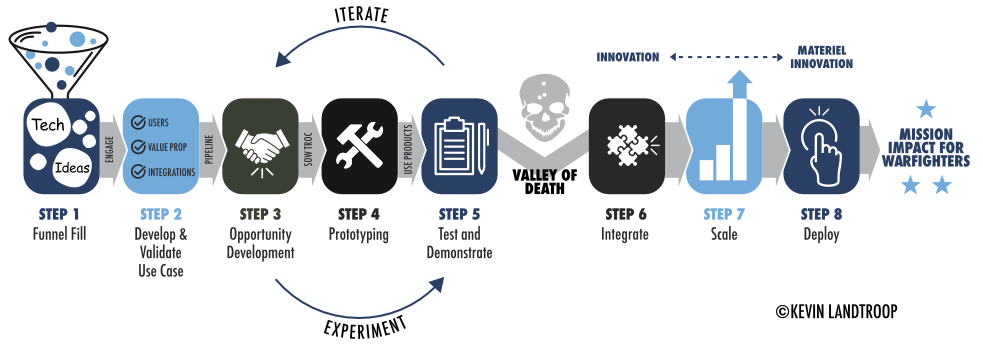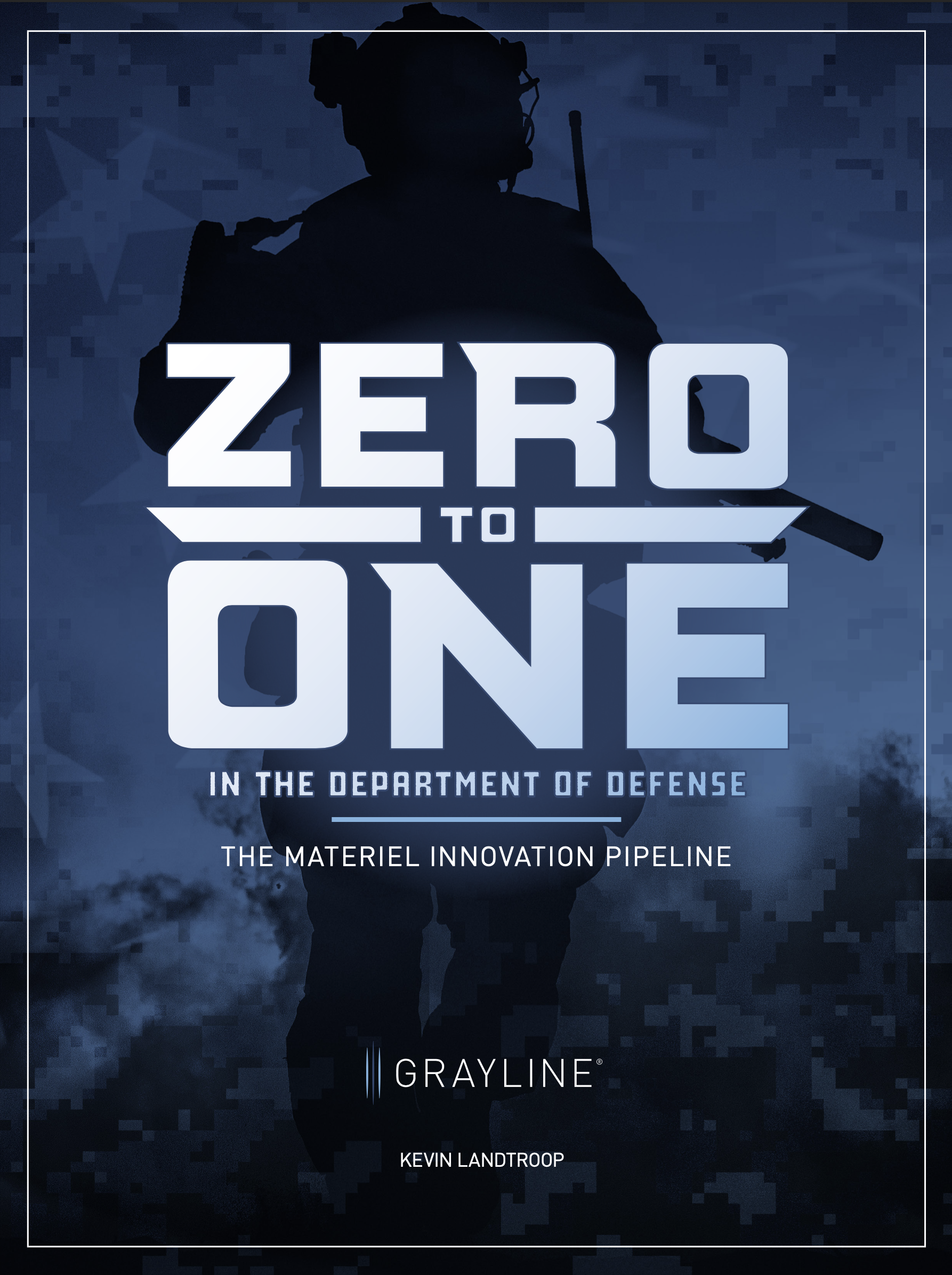Grayline Defense is proud to publish Zero to One in the DOD: The Materiel Innovation Pipeline, and announce the launch of Applied Innovation for National Security, a new executive education program at The University of Texas at Austin intended to deliver on the mandate to bring technology and innovation education to military professionals. Both represent the culmination of years of research and field work developing and delivering technology innovation to the national security community.
There is no longer a reasonable debate over whether the Department of Defense (DOD) needs innovative technology from venture-funded companies – startups, who in most cases have been validated by the riskiest private sector investors. The private sector funds three-quarters of all research & development (R&D) in the United States, and the war in Ukraine has provided overwhelming operational validation for emerging technologies from the commercial sector (examples are discussed here, here, and here). That’s the good news.
Now the bad news. Despite substantial evidence of the benefits of adopting privately-funded technology, it is equally clear that the defense innovation movement hasn’t yet disrupted the materiel enterprise. The defense innovation movement has created its own innovation ecosystem (good!) of networking, conferences, prize competitions, and senior leader-endorsed blue-sky creativity. Strikingly absent is a consistent and proven pathway for funding and moving a technology from prototype to deployment and sustainment at scale.
There have been some signals of disruption: Anduril has a billion-dollar DOD contract, and Palantir has several notable awards pushing its total DOD business well north of $1 billion. A cohort of defense unicorns has emerged as validation that the dual-use model works, both for investors and the military. Success of the so-called SHARPE group (Shield AI, Hawkeye 360, Anduril, Rebellion Defense, Palantir, and Epirus) is providing cover for a Defense Innovation System that is not yet functioning at full operational capacity, and a deeper look at their success reveals two critical flaws. First, both Steve Blank and Jeff Decker have observed (accurately, in our opinion) that only billionaire-founded companies seem to be winning at scale. Second, the “made-for DOD” startup model continues to prove the point that the Defense Acquisition System doesn’t work for ordinary startups. Neither prerequisite – billionaire founder, or a DOD-centric business plan – is sustainable or scalable, and both encourage an innovation model that simply replaces one entrenched defense industrial base with another.
For the Defense Innovation System to truly feed materiel innovation, the DOD needs a model that enables any startup (or at least most) to leap the valley separating the Defense Innovation System from the Defense Acquisition System. Yes, this oft-maligned Valley of Death is real, and formidable, but not impossible. In 1938, Central Texas was on the frontier of military aviation; five years later, dozens of new military airfields and training bases dotted the Rio Grande Valley and wrapped up the western half of the state from San Antonio to Amarillo. This was real innovation, applied to real problems, scaled across the military and the country – and many of those bases remain active today.
We sit again on a new frontier of materiel innovation. The Defense Innovation System completed its build-out here, in Central Texas, in 2018 with the activation of Army Futures Command, creation of the Army Applications Laboratory, and launch of the Air Force Open Topic SBIR. In the four-plus years that have elapsed since, we have directly advised nearing 100 dual-use startups. We’ve designed and executed accelerator programs that have touched many hundreds more, helping companies develop use cases, validate them with users and customers, and connect to prime partners and investors. We’ve co-founded one of the country’s largest OTA Consortium management organizations. We’ve seen the problem from the perspective of Fortune 100 companies struggling to innovate for the future, the office of the Chief of Staff of the United States Army, and the office of the President of one the largest flagship universities in the nation. We’ve even been inside a made-for DOD artificial intelligence startup, trying to align commercial products, military use cases, and customers. Our combined perspectives have helped us form a new vision for how to transition emerging technology at scale.
What have we seen? Regardless of the industry, and whether software or hardware, all dual-use technology startups face similar issues. A good use case requires connection to users and should account for integration factors before prototyping begins. Defense applications should align with the commercial product roadmap and go-to-market strategies. All of these lessons have informed development of the Materiel Innovation Pipeline (MiP), an eight-step process to develop and deliver materiel innovations that provide mission impact to warfighters at the speed of relevance. Stated differently, this is how the materiel enterprise evolves from a system that works for only a few startups at best, or produces innovation theater at worst, to a repeatable process to integrate, scale, and deploy innovative materiel solutions from any startup.
 The Materiel Innovation Pipeline, along with the foundational core concepts and an overview of the Defense Innovation System, are described in detail in our newly released whitepaper called Zero to One in the DOD. The first five steps of the MiP have been proven and are running like a well-oiled machine, with hundreds of successful prototypes delivered annually from a diverse cohort of non-traditional technology providers. The success story of the first half of the MiP is the direct result of the inspiration and perspiration of AFWERX, xTechSearch, Army Applications Laboratory, Defense Innovation Unit, National Security Innovation Network, SOFWERX, and more. Steps 6-8 sit across the Valley, on the unsettled frontier, waiting for bold professionals to step up and lead US national security into the future.
The Materiel Innovation Pipeline, along with the foundational core concepts and an overview of the Defense Innovation System, are described in detail in our newly released whitepaper called Zero to One in the DOD. The first five steps of the MiP have been proven and are running like a well-oiled machine, with hundreds of successful prototypes delivered annually from a diverse cohort of non-traditional technology providers. The success story of the first half of the MiP is the direct result of the inspiration and perspiration of AFWERX, xTechSearch, Army Applications Laboratory, Defense Innovation Unit, National Security Innovation Network, SOFWERX, and more. Steps 6-8 sit across the Valley, on the unsettled frontier, waiting for bold professionals to step up and lead US national security into the future.
Integration, Scaling, and Deployment – the steps to a successful transition – need more reps. But transition reps are harder, as there are only so many programs of record, and the entire defense innovation experiment to-date has taken place within the course of two PPBE (Planning, Programming, Budgeting, and Execution) cycles. To provide the intellectual reps required to develop an innovation transition playbook, we have developed and are now launching Applied Innovation for National Security (AINS), an executive graduate certification program at The University of Texas at Austin’s McCombs School of Business. AINS guides professionals within the materiel enterprise through an education, research, and discovery process so that they can write discrete transition pathways which will collectively become innovation transition doctrine. AINS students are the Cavalry who will settle the wild frontier of defense innovation. We are proud to be their scouts, and we hope you will join us.
Click here to download Zero to One in the DOD: The Materiel Innovation Pipeline,
This post was written by Kevin Landtroop, Joseph Kopser, and Will Dickson. Kevin is a dual-use technology strategist and entrepreneur, and Joseph is the President of Grayline Group and Special Advisor to the President of The University of Texas at Austin for military strategy and policy. Both are former Cavalry officers, though serving well after the frontier was settled. Will is an MIT-trained engineer who has led technology innovation initiatives for General Motors and the DOD.
Join the Catalyst Monitor
Join our community, where we push out regular insights to help maintain situational awareness on technological and socioeconomic trends.



